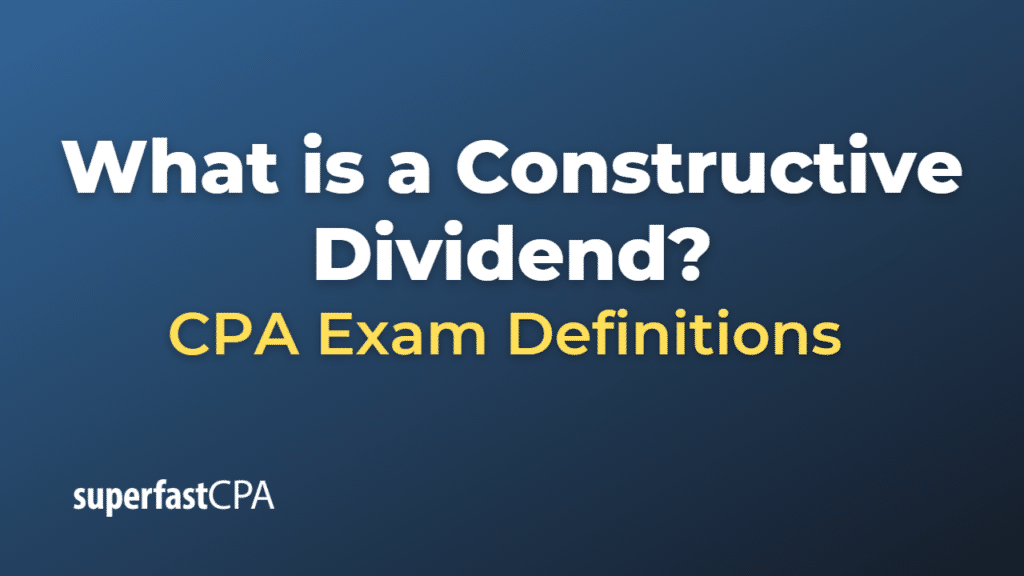Constructive Dividend
A constructive dividend is an economic benefit provided by a corporation to its shareholders that is not explicitly classified as a dividend but is still considered a dividend for tax purposes. Constructive dividends often arise when a corporation confers a benefit to a shareholder that goes beyond normal compensation or fair market value. In such cases, tax authorities may treat these benefits as dividends, and they become subject to dividend tax rates.
Constructive dividends can take various forms, including:
- Excessive compensation: If a corporation pays excessive salaries, bonuses, or other forms of compensation to its shareholder-employees, the portion considered above the reasonable compensation for their services may be treated as a constructive dividend.
- Below-market loans: If a corporation provides a loan to a shareholder at an interest rate significantly below market rates, the difference between the interest paid and the market rate interest may be considered a constructive dividend.
- Personal expenses: If a corporation pays for personal expenses of its shareholders, such as vacations, club memberships, or personal use of company vehicles, these expenses may be treated as constructive dividends.
- Property transfers: If a corporation sells or leases property to a shareholder at a price significantly below or above its fair market value, the difference between the transaction price and the fair market value may be deemed a constructive dividend.
Constructive dividends are primarily a concern for closely-held corporations, where the shareholders are often actively involved in managing the business, and there may be a higher likelihood of transactions between the corporation and its shareholders. It is essential for corporations to maintain accurate records and ensure that transactions with shareholders are conducted at arm’s length to avoid potential tax implications related to constructive dividends.
In summary, a constructive dividend is an economic benefit provided by a corporation to its shareholders that is not explicitly classified as a dividend but is treated as such for tax purposes. These benefits can take various forms, such as excessive compensation, below-market loans, personal expense coverage, or property transfers. To avoid potential tax implications, corporations should conduct transactions with shareholders at arm’s length and maintain accurate records.
Example of a Constructive Dividend
Let’s consider an example of a closely-held corporation, ABC Corp, owned by two siblings, Alice and Bob. ABC Corp is involved in the manufacturing business.
- Excessive compensation: Alice and Bob, who are also the top executives of ABC Corp, decide to pay themselves annual salaries of $500,000 each, while the average salary for similar positions in their industry is $250,000. In this case, the Internal Revenue Service (IRS) may consider the excess compensation of $250,000 each ($500,000 – $250,000) as constructive dividends and subject them to dividend tax rates.
- Below-market loans: ABC Corp provides a loan of $200,000 to Alice at a 2% annual interest rate, while the prevailing market interest rate for similar loans is 6%. The difference between the interest Alice pays on the loan (2%) and the market interest rate (6%) may be deemed a constructive dividend by the IRS.
- Personal expenses: ABC Corp pays for Bob’s family vacation expenses, amounting to $10,000. Since this is a personal expense and not a business-related one, the IRS may treat the $10,000 as a constructive dividend for Bob.
- Property transfers: ABC Corp leases a piece of land to Alice for $1,000 per month, while the fair market value for leasing the land is $2,500 per month. The difference between the lease amount paid by Alice ($1,000) and the fair market value ($2,500) represents a benefit of $1,500 per month or $18,000 per year. The IRS may consider this $18,000 as a constructive dividend for Alice.
In this example, Alice and Bob received various economic benefits from ABC Corp that were not explicitly classified as dividends. However, due to the nature of these benefits, tax authorities could treat them as constructive dividends, subjecting Alice and Bob to dividend tax rates on these amounts. To avoid potential tax implications, ABC Corp should ensure that transactions with shareholders, such as compensation, loans, and property transfers, are conducted at arm’s length and maintain accurate records.













